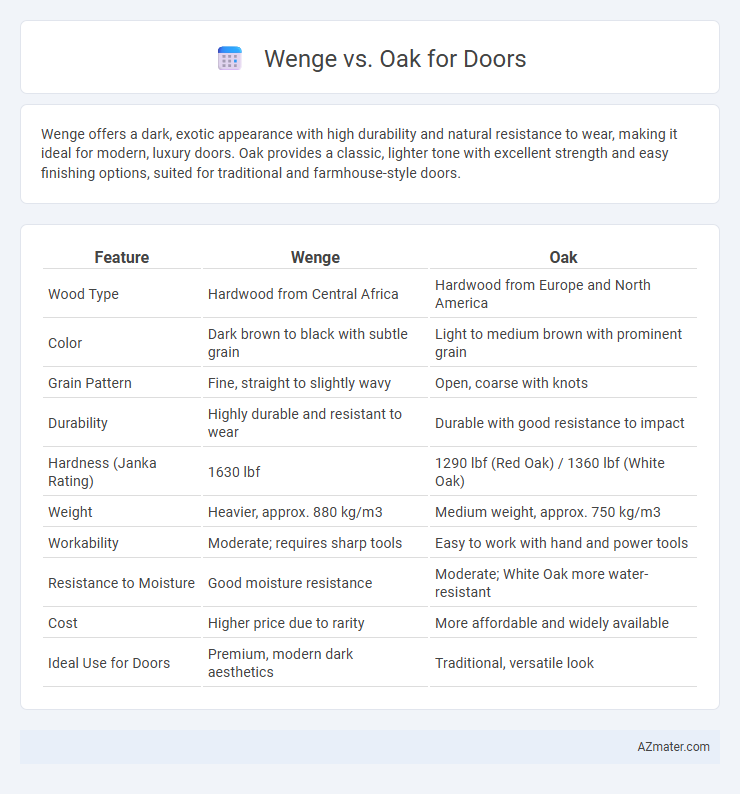Wenge offers a dark, exotic appearance with high durability and natural resistance to wear, making it ideal for modern, luxury doors. Oak provides a classic, lighter tone with excellent strength and easy finishing options, suited for traditional and farmhouse-style doors.
Table of Comparison
| Feature | Wenge | Oak |
|---|---|---|
| Wood Type | Hardwood from Central Africa | Hardwood from Europe and North America |
| Color | Dark brown to black with subtle grain | Light to medium brown with prominent grain |
| Grain Pattern | Fine, straight to slightly wavy | Open, coarse with knots |
| Durability | Highly durable and resistant to wear | Durable with good resistance to impact |
| Hardness (Janka Rating) | 1630 lbf | 1290 lbf (Red Oak) / 1360 lbf (White Oak) |
| Weight | Heavier, approx. 880 kg/m3 | Medium weight, approx. 750 kg/m3 |
| Workability | Moderate; requires sharp tools | Easy to work with hand and power tools |
| Resistance to Moisture | Good moisture resistance | Moderate; White Oak more water-resistant |
| Cost | Higher price due to rarity | More affordable and widely available |
| Ideal Use for Doors | Premium, modern dark aesthetics | Traditional, versatile look |
Introduction to Wenge and Oak Doors
Wenge doors showcase a rich, dark brown color with distinctive black streaks, offering a luxurious and contemporary aesthetic ideal for modern interiors. Oak doors provide a classic appearance with their light to medium brown hues and prominent grain patterns, known for exceptional durability and timeless appeal. Both materials are valued for their strength and ability to enhance interior design, making the choice dependent on desired style and ambiance.
Appearance and Color Differences
Wenge doors feature a deep, rich brown color with striking, dark veins that create a luxurious, dramatic appearance, making them ideal for modern or contemporary interiors. Oak doors display a lighter, warm golden to medium brown hue with a prominent grain pattern, offering a classic, timeless look suitable for traditional and rustic styles. Both woods provide distinctive aesthetics; Wenge's bold contrast versus Oak's natural warmth allows for diverse design choices based on desired ambiance and color schemes.
Durability and Hardness Comparison
Wenge wood exhibits a Janka hardness rating of approximately 1,930 lbf, making it significantly harder and more durable than oak, which ranges from 1,200 to 1,360 lbf depending on the species (red or white oak). The dense grain structure of wenge enhances its resistance to dents, scratches, and wear, making it ideal for high-traffic door applications. Oak offers strong durability as well but is more prone to surface impacts and requires more maintenance to preserve its integrity compared to wenge.
Cost and Value Considerations
Wenge doors generally cost more than oak doors due to the exotic nature and limited availability of wenge wood, often appealing to high-end markets seeking unique aesthetics. Oak offers a more affordable and widely available option, providing excellent durability and a classic look that adds substantial value to residential and commercial properties. Evaluating long-term investment, oak doors deliver strong cost-effectiveness with lower maintenance expenses, while wenge's premium price might be justified by its distinctive appearance and perceived luxury.
Maintenance and Care Requirements
Wenge doors require minimal maintenance, needing only occasional dusting and wiping with a damp cloth to preserve their rich, dark finish. Oak doors demand regular polishing and sealing to protect against moisture and maintain their natural grain patterns. Both woods benefit from avoiding harsh chemicals and exposure to extreme humidity to ensure long-lasting durability and aesthetic appeal.
Environmental Impact and Sustainability
Wenge wood, sourced primarily from Central African rainforests, presents concerns due to its slow growth rate and habitat disruption, leading to higher environmental impact compared to Oak. Oak, widely available from sustainably managed forests in North America and Europe, offers greater renewability and carbon sequestration benefits, making it a more sustainable choice for door materials. Selecting Oak over Wenge supports eco-friendly forestry practices and reduces deforestation pressures associated with tropical hardwood harvesting.
Best Use Cases for Wenge Doors
Wenge doors are ideal for modern and luxury interiors due to their rich, dark brown color and distinctive grain pattern, which add a sense of elegance and sophistication. Their dense and durable hardwood nature makes them perfect for high-traffic areas requiring strong, long-lasting doors. Wenge excels in contemporary spaces where bold, dramatic aesthetics are desired, contrasting well with lighter walls and minimalist decor.
Best Use Cases for Oak Doors
Oak doors offer exceptional durability and resistance to warping, making them ideal for both interior and exterior applications in high-traffic areas. Their fine grain and warm, natural tones enhance traditional and contemporary designs, providing excellent aesthetic versatility. Oak's strong structural integrity and ease of finishing make it a preferred choice for entry doors, emphasizing security and long-lasting performance.
Design Versatility and Finishing Options
Wenge offers a rich, dark brown hue with deep grain patterns that create a luxurious and modern aesthetic ideal for contemporary door designs. Oak provides a lighter, warm tone with a classic grain structure, allowing versatile finishes from natural stains to painted options suited for traditional or rustic styles. Both woods accommodate various finishes, but wenge's distinct color requires careful selection of complementary hardware, while oak's neutral palette enhances adaptability in diverse interior design schemes.
Choosing the Right Wood for Your Door
Wenge offers exceptional durability and a rich, dark brown color with subtle black streaks, ideal for creating a modern, elegant door design. Oak provides a classic, warm appearance with strong grain patterns and excellent strength, making it a popular choice for traditional and rustic door styles. Selecting the right wood depends on your aesthetic preferences, desired durability, and maintenance requirements, with wenge favoring contemporary luxury and oak suited for timeless, sturdy doors.

Infographic: Wenge vs Oak for Door
 azmater.com
azmater.com